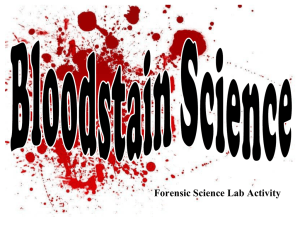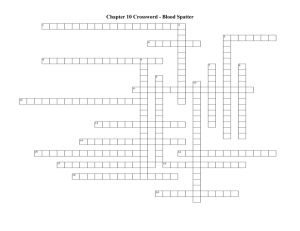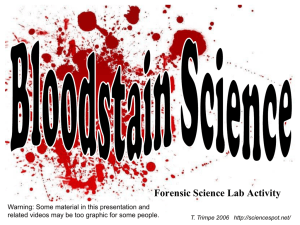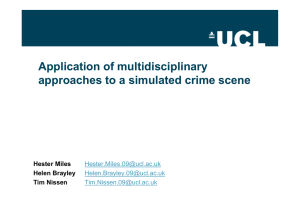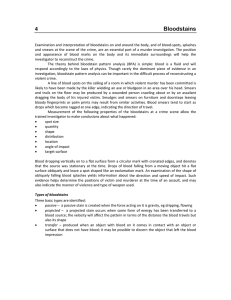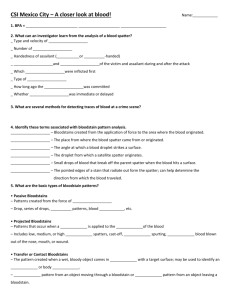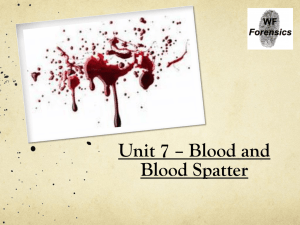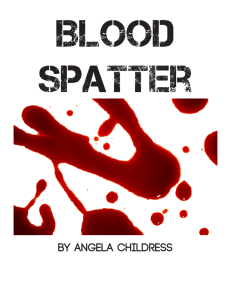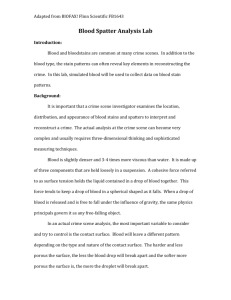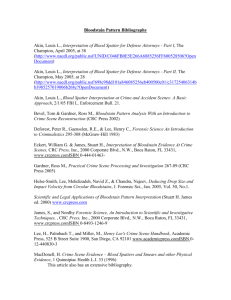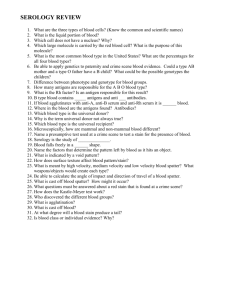Forensic Science - Leermiddel digischool
advertisement
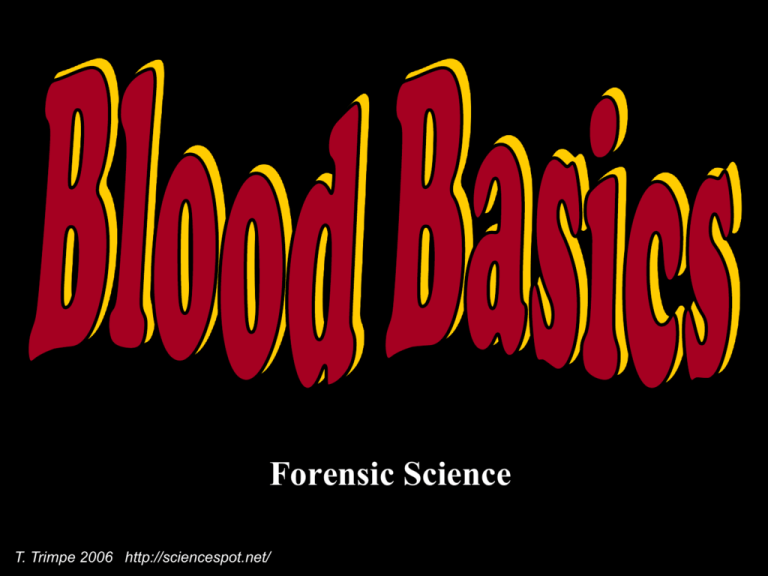
Forensic Science T. Trimpe 2006 http://sciencespot.net/ What makes up our blood? • RED BLOOD CELLS (Erythrocytes) – The most abundant cells in our blood; they are produced in the bone marrow and contain a protein called hemoglobin that carries oxygen to our cells. • WHITE BLOOD CELLS (Leukocytes) – They are part of the immune system and destroy infectious agents called pathogens. • PLASMA – This is the yellowish liquid portion of blood that contains electrolytes, nutrients and vitamins, hormones, clotting factors, and proteins such as antibodies to fight infection. • PLATELETS (Thrombocytes) – The clotting factors that are carried in the plasma; they clot together in a process called coagulation to seal a wound and prevent a loss of blood. Blood Facts The average adult has about FIVE liters of blood inside of their body, which makes up 7-8% of their body weight. Blood is living tissue that carries oxygen and nutrients to all parts of the body, and carries carbon dioxide and other waste products back to the lungs, kidneys and liver for disposal. It also fights against infection and helps heal wounds, so we can stay healthy. There are about one billion red blood cells in two to three drops of blood. For every 600 red blood cells, there are about 40 platelets and one white cell. http://www.bloodbankofalaska.org/about_blood/index.html Genetics of Blood Types • Your blood type is established before you are BORN, by specific GENES inherited from your parents. • These two genes - one gene from your MOTHER and one from your FATHER determine your blood type by causing proteins called AGGLUTINOGENS to exist on the surface of all of your red blood cells. What are blood types? Blood Types There are 3 alleles or genes for blood type: A, B, & O. Since we have 2 genes, there are 6 possible combinations. AA or AO = Type A BB or BO = Type B OO = Type O AB = Type AB http://learn.genetics.utah.edu/units/basics/blood/types.cfm How common is your blood type? Rh Factors • Scientists sometimes study Rhesus monkeys to learn more about the human anatomy because there are certain similarities between the two species. While studying Rhesus monkeys, a certain blood protein was discovered. This protein is also present in the blood of some people. Other people, however, do not have the protein. • The presence of the protein, or lack of it, is referred to as the Rh (for Rhesus) factor. • If your blood does contain the protein, your blood is said to be Rh positive (Rh+). If your blood does not contain the protein, your blood is said to be Rh negative (Rh-). http://www.fi.edu/biosci/blood/rh.html A+ AB+ BAB+ ABO+ O- Blood Transfusions A blood transfusion is a procedure in which blood is given to a patient through an intravenous (IV) line in one of the blood vessels. Blood transfusions are done to replace blood lost during surgery or a serious injury. A transfusion also may be done if a person’s body can't make blood properly because of an illness. Who can give you blood? Universal Donor People with TYPE O blood are called Universal Donors, because they can give blood to any blood type. People with TYPE AB blood are called Universal Recipients, because they can receive any blood type. Rh + Can receive + or Rh - Can only receive Universal Recipient Microscopic Views Fish Blood Bird Blood Horse Blood Frog Blood Cat Blood Dog Blood Human Blood Snake Blood What does the abbreviation BPA represent? Bloodstain Pattern Analysis What can an investigator learn from the analysis of a blood spatter? Type and velocity of weapon Number of blows Handedness of assailant (right or left-handed) Position and movements of the victim and assailant during and after the attack Which wounds were inflicted first Type of injuries How long ago the crime was committed Whether death was immediate or delayed Source: http://science.howstuffworks.com/bloodstain-pattern-analysis1.htm http://www.crimescenetwo.com/img/popup/book2p2.jpg How is blood evidence detected at a crime scene? Light Source Investigators will first examine the crime scene to look for areas that may contain blood. They may use a high-intensity light or UV lights to help them find traces of blood as well as other bodily fluids that are not visible under normal lighting conditions. Blood Reagent Tests These tests, referred to as presumptive tests, are used to detect blood at crime scenes based upon the properties of hemoglobin in the blood. Further tests at the crime lab can determine if it is human blood or not. Kastle-Meyer Test Video Examples: • Phenolphthalein is a chemical that is still utilized today and is usually referred to as the Kastle-Meyer test and produces a pink color when it reacts with hemoglobin. •HemaStix is a strip that has been coated with tetramethylbenzidine (TMB) and will produce a green or bluegreen color with the presence of hemoglobin. HemaStix Luminol This chemical is used by crime scene investigators to locate traces of blood, even if it has been cleaned or removed. Investigators spray a luminol solution is throughout the area under investigation and look for reactions with the iron present in blood, which causes a blue luminescence. One problem is that other substances also react, such as some metals, paints, cleaning products, and plant materials. Another problem is that the chemical reaction can destroy other evidence in the crime scene. Fluorescein This chemical is also capable of detecting latent or old blood, similar to luminol. It is ideal for fine stains or smears found throughout a crime scene. After the solution has been sprayed onto the substance or area suspected to contain blood, a UV light and goggles are used to detect any illuminated areas, which appear greenish-white if blood is present. It may also react to many of the same things as luminol (copper and bleach). Luminol Reaction Fluorescein Reaction in UV Light LCV or Leuco Crystal Violet, is one type of chemical process that is used for blood enhancement. Using this test helps to make the blood evidence more visible so it can be photographed and analyzed. Bloodstain Pattern Analysis Terms • Spatter – Bloodstains created from the application of force to the area where the blood originated. • Origin/Source – The place from where the blood spatter came from or originated. • Angle of Impact – The angle at which a blood droplet strikes a surface. • Parent Drop – The droplet from which a satellite spatter originates. • Satellite Spatters – Small drops of blood that break of from the parent spatter when the blood droplet hits a surface. • Spines – The pointed edges of a stain that radiate out from the spatter; can help determine the direction from which the blood traveled. Satellite Spatters Spines Parent Drop Types of Bloodstain Patterns Blood Spatter Movie • Passive Bloodstains – Patterns created from the force of gravity – Drop, series of drops, flow patterns, blood pools, etc. • Projected Bloodstains – Patterns that occur when a force is applied to the source of the blood – Includes low, medium, or high impact spatters, castoff, arterial spurting, expiratory blood blown out of the nose, mouth, or wound. • Transfer or Contact Bloodstains – These patterns are created when a wet, bloody object comes in contact with a target surface; may be used to identify an object or body part. – A wipe pattern is created from an object moving through a bloodstain, while a swipe pattern is created from an object leaving a bloodstain. Images from http://www.bloodspatter.com/BPATutorial.htm
